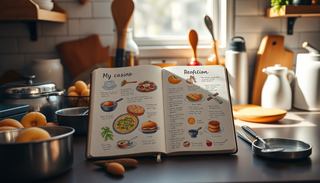Have you ever caught yourself wondering what you ate yesterday, or how certain meals affect your mood, energy, or focus? You're not alone. In a world of fast food, skipped breakfasts, and takeout dinners, it’s easy to lose sight of how we nourish ourselves.
That’s where bullet journaling meets mindful eating. Creating a meal journal with bullet journaling isn't just about planning meals—it's about reconnecting with your food, your body, and your goals.
Whether you want to be more intentional with your nutrition, manage emotional eating, or simply feel better each day, this guide will help you turn a blank notebook into a powerful wellness tool.
The Power of Meal Journaling
Meal journaling is more than just a way to track what you eat. It's a powerful tool for self-discovery, mindfulness, and personal growth. By taking the time to record and reflect on your meals, you can:
1. Gain Insights into Your Eating Habits
A meal journal allows you to see patterns and trends in your eating habits that you might not have noticed before. Are there certain times of day when you tend to overeat? Do you find yourself reaching for unhealthy snacks when you're feeling stressed? By keeping track of what, when, and why you're eating, you can identify areas for improvement and make more informed decisions about your diet.
2. Improve Your Relationship with Food
Meal journaling can help you develop a more mindful and positive relationship with food. By taking the time to savor and appreciate each meal, you can cultivate a deeper sense of gratitude and connection to the nourishment you're putting into your body. This can lead to a more balanced and fulfilling approach to eating, rather than viewing food as a source of guilt or stress.
3. Enhance Your Overall Wellbeing
When you're more mindful about your eating habits, you're more likely to make choices that support your physical and mental health. A meal journal can help you identify triggers for emotional or stress-related eating, as well as track how certain foods make you feel. This can empower you to make adjustments that improve your energy levels, digestion, and overall sense of wellbeing.
The Elements of a Meal Journal
Now that you understand the benefits of meal journaling, let's dive into the key elements to include in your bullet journal. Remember, the beauty of bullet journaling is that it's a highly personalized system, so feel free to adapt these suggestions to fit your unique needs and preferences.
What You’ll Need to Get Started
You don’t need anything fancy. Here's a simple list to get going:
-
A notebook (dot grid or blank works best)
-
Pens, markers, or highlighters (just for fun!)
-
Optional: washi tape, sticky notes, or stickers for motivation
The beauty of bullet journaling is that it’s totally customizable. If you like things minimal, keep it clean. If you thrive on color and art, go wild.

Meal Journal Layout Ideas You Can Try
These spread ideas give you flexibility depending on your goals. Mix and match what speaks to you!
1. Weekly Meal Log
Track your breakfasts, lunches, dinners, and snacks throughout the week. You can add columns for water intake, energy level, or mood after each meal.
Example Columns:
-
Date
-
Meal
-
What I Ate
-
Mood After
-
Energy Level
2. Meal Planning Spread
Prep your week in advance to reduce decision fatigue. Use it to plan grocery lists, prep days, and ingredients to use up.
Bonus Tip: Add a “what’s in my fridge” section to minimize food waste.
3. Food & Mood Tracker
This is powerful for identifying emotional eating patterns or foods that trigger stress, anxiety, or fatigue.
Try asking yourself:
-
Was I really hungry?
-
How did I feel after?
-
Did this meal serve me emotionally or physically?
4. Nutrition & Goal Tracker
Set personalized goals like eating more fiber, cutting added sugar, or increasing protein. Track your progress daily or weekly.
Hacks to try: Use habit tracker-style layouts with checkboxes for each nutrient or food group.
5. Recipe Collections
Keep a log of meals you loved. Include ingredients, prep notes, and even ratings.
It becomes your go-to when you don’t know what to cook but still want to eat something satisfying.

Emotional Eating? Your Journal Can Help
Sometimes we eat not because we're hungry, but because we’re stressed, bored, or upset. It happens. Bullet journaling offers a gentle way to notice these patterns without judgment.
Try adding a small reflection question in your daily spread:
-
What was I feeling before I ate?
-
What did I really need?
-
What can I try next time instead of eating?
By identifying triggers, you give yourself the power to choose different responses. Over time, you’ll gain more emotional clarity—and that can be life-changing.
Want to dive deeper into emotional eating? Check out this trusted resource from the National Eating Disorders Association.
Tips to Stay Consistent
Let’s be real: keeping a meal journal might feel exciting at first, but habits are hard to stick to. Here’s how to make it sustainable:
-
Keep it simple. A few minutes a day is enough.
-
Do it your way. There’s no "right" format. Create what works for you.
-
Combine it with your daily journal or planner. It makes journaling feel less like a chore.
-
Add a little joy. Use fun stickers, color code your moods, or include a daily food quote.
-
Don’t aim for perfection. Aim for awareness.
Real-Life Benefits You’ll Start to Notice
Still wondering if a meal journal is worth it? Here’s what people often report after a few weeks of consistent bullet journaling:
-
Less mindless snacking
-
More energy in the afternoons
-
Fewer crashes and sugar cravings
-
Feeling more in tune with their body
-
Saving money by avoiding impulse takeout
-
Cooking more balanced meals
Doesn’t that sound like the kind of life you want to create?
You Deserve to Feel Good in Your Body
This isn’t about restriction. It’s about attention. And attention builds self-trust.
By writing down what you eat, how you feel, and what you need, you're sending a powerful message to yourself: I matter. My health matters. My story matters.
Even if you start small, you're starting something beautiful.

Ready to Begin?
Grab a notebook. Draw your first layout. Reflect on today. That’s it.
You don’t need all the answers right now. Just start with curiosity. This is your journey—and your meal journal will be your guide.
Want inspiration from others who meal journal? Browse Reddit’s r/bujo community to see how real people bring their food trackers to life.
You got this. One page at a time.




